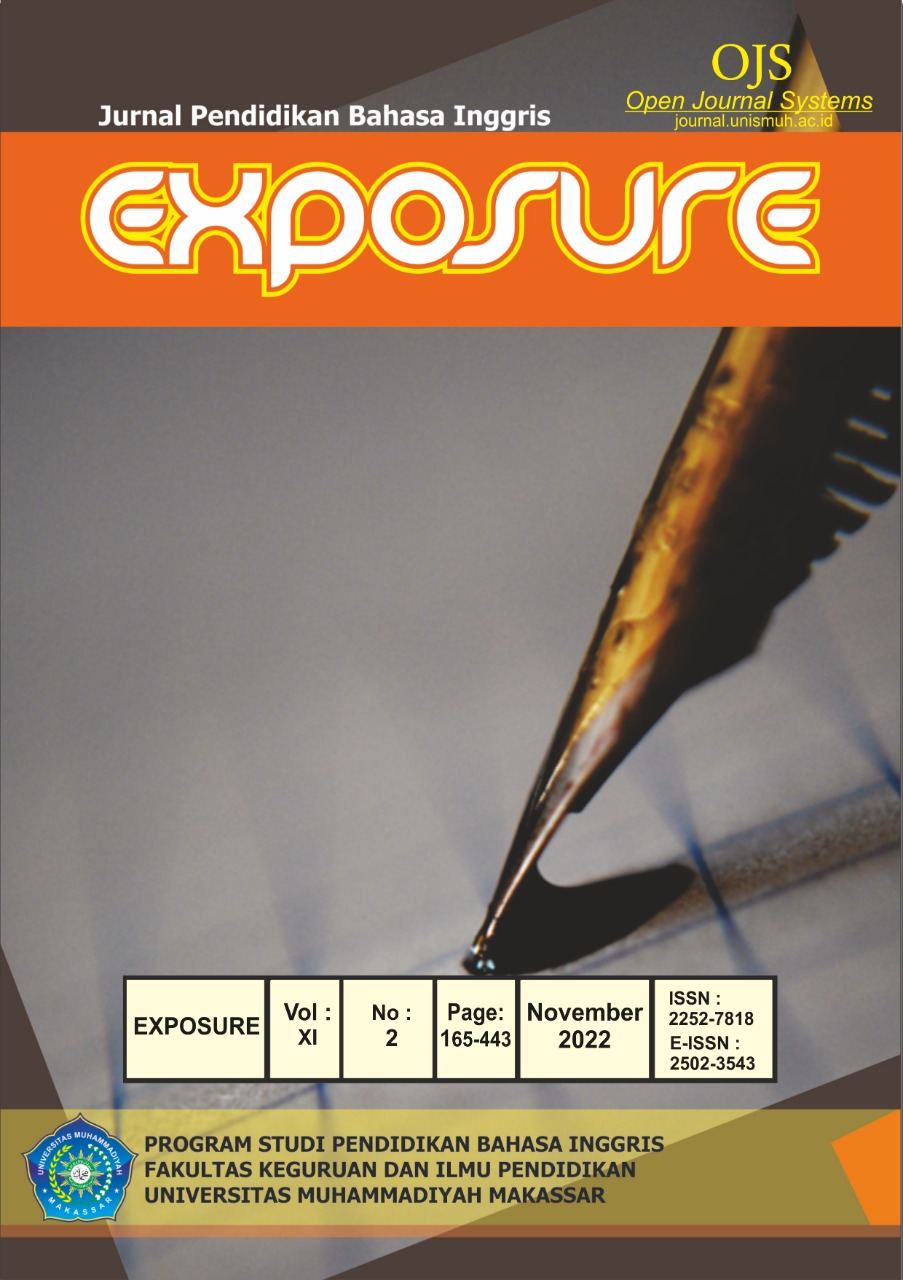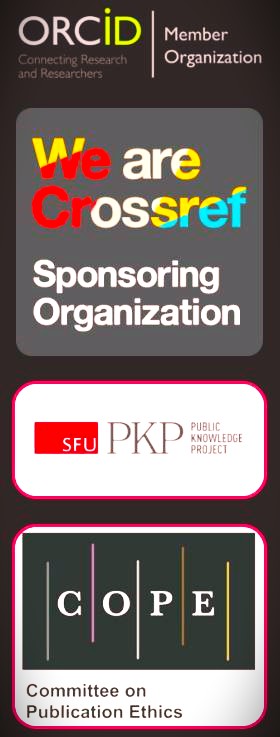ANXIETY AND DEFENESE MECHANISMS PORTRAYED IN “CAT ON A HOT TIN ROOF”
DOI: https://doi.org/10.26618/exposure.v11i2.8721
Anxiety, Defense, Mechanisms
Abstract
Born and raised in a poor family, a childless woman named Margaret who is a wife of an alcoholic, has an ambition for wealth which eventually causes her to live with anxiety. To suppress the anxiety, she uses defense mechanisms. Therefore, this study was conducted to analyze the anxiety and defense mechanisms portrayed through Margaret in the drama, entitled “Cat on a Hot Tin Roof”. This qualitative study analyzed the anxiety and defense mechanisms portrayed in one of the canonical drama of Tennessee Williams using psychological lens. The data describing Margaret's anxiety and defense mechanisms collected from this drama were revealed and interpreted descriptively in order to provide detailed explanation and deep understanding. This study identified that the anxiety experienced by Margaret was resulted from her ambition to inherit the wealth of her father-in-law. Poverty in her past life has led her to become ambitious to pursue her dreams of wealth. Besides, she got anxious about her inability to give a child to her husband. In consequence, her childlessness caused her to have anxiety. To cope with the anxiety, she used three types of defense mechanisms: (1) reaction formation, (2) displacement, and (3) denial. The female major character experiences anxiety about wealth and childlessness. To protect herself from the anxiety, she uses reaction formation, displacement, and denial as defense mechanisms.
References
Association, A. P. (2021). What Are Anxiety Disorders? Anxiety Disorders Retrieved 10 March, 2022, from https://www.psychiatry.org/patients-families/anxiety-disorders/what-are-anxiety-disorders
Cherry, K. (2021). Denial as a Defense Mechanism. Retrieved from https://www.verywellmind.com/denial-as-a-defense-mechanism-5114461
Cherry, K. (2022). 20 Common Defense Mechanisms Used for Anxiety. Retrieved from https://www.verywellmind.com/defense-mechanisms-2795960
Corey, G. (2009). Theory and Practice of Counseling and
Psychotherapy (8th ed.). Belmont, CA: Thomson Brooks/Cole.
Creswell, J. W. (2012). Educational Research: Planning, Conducting, and Evaluating Quantitative and Qualitative Research. Boston, MA. : Pearson Education, Inc.
Cummings, J. A., & Sanders, L. (2019). Introduction to Psychology. Saskatoon: University of Saskatchewan Open Press.
Dornyei, Z. (2007). Research Method In Applied Linguistics: Qualitative, Quantitative, and Mix Methodologies. . New York: Oxford University Press.
Ewen, R. B. (2003). An Introduction to Theories of Personality (Sixth Edition). New Jersey: Lawrence Erlbaum Associates, Inc.
Holland, K. (2022, June 21, 2022). 10 Defense Mechanisms: What Are They and How They Help Us Cope Retrieved Aug 22, 2022 2022, from https://www.healthline.com/health/mental-health/defense-mechanisms
Kim, E., Zeppenfeld, V., & Cohen, D. (2013). Sublimation, culture, and creativity. J Pers Soc Psychol, 105(4:639-66). doi: 10.1037/a0033487
Macdonald K, T. M., Sciolla AF, et al. (2016). Minimization of childhood maltreatment is common and consequential: Results from a large, multinational sample using the childhood trauma questionnaire. PLoS ONE. 2016;11(1), 11(1:e0146058.). doi: 10.1371/journal.pone.0146058
McLeod, S. (2019). Defense Mechanisms. Simply Psychology Retrieved 10 March, 2022, from
https://www.simplypsychology.org/defense-mechanisms.html
McLeod, S. (2020). 10 Defense Mechanisms: What Are They and How They Help Us Cope, 2022, from https://www.simplypsychology.org/defense-mechanisms.html#:~:text=Defense%20mechanisms%20are%20psyc
hological%20strategies,to%20cope%20with%20a%20situation.
Plumptre, E. (2021). Why Is Mental Health Important? Retrieved from https://www.verywellmind.com/the-importance-of-mental-health-for-wellbeing-5207938
Pruitt, S. (2016). 5 Myths About Slavery. Retrieved from https://www.history.com/news/5-myths-about-slavery
Singh, A. (2015). Psychological Factors Affecting Personality Development. International Journal of Physical Education, Sports and Health 1(3), 78-80.
Soto, C. J., & Jackson, J. J. (2020). Five-Factor Model of Personality. In D. S. Dunn (Ed.), Oxford Bibliographies in Psychology. New York: Oxford.
Tackett, J. L. (2017). The Oxford Handbook of the Five Factor Model. New York: Oxford University Press.
Tartakovsky, M. (2014). Psych Central: The Truth About Anxiety Retrieved 6 June, 2015, from http://psychcentral.com/blog/archives/2014/10/14/the-truth-about-anxiety/
Tyson, L. (2006). Critical Theory Today (Second ed.). New York: Routledge.
Vinney, C. (2022). What Is Reaction Formation? Retrieved from https://www.verywellmind.com/reaction-formation-is-5190404#:~:text=In%20psychology%2C%20reaction%20formation%20is,level%2C%20he's%20attracted%20to%20her.
Wellek, R., & Warren, A. (1970). Theory of Literature Middlesex, England Penguin Books.
Yin, R. K. (2011). Qualitative Research From Start to Finish. New York: The Guilford. Press.
Downloads
Published
How to Cite
Issue
Section
License
Authors who publish with this journal agree to the following terms:
In order to assure the highest standards for published articles, a peer review policy is applied. In pursue of the compliance with academic standards, all parties involved in the publishing process (the authors, the editors and the editorial board and the reviewers) agree to meet the responsibilities stated below in accordance to the Journal publication ethics and malpractice statement.
Duties of Authors:
- The author(s) warrant that the submitted article is an original work, which has not been previously published, and that they have obtained an agreement from any co-author(s) prior to the manuscript’s submission;
- The author(s) should not submit articles describing essentially the same research to more than one journal;
- The authors(s) make certain that the manuscript meets the terms of the Manuscript Submission Guideline regarding appropriate academic citation and that no copyright infringement occurs;
- The authors(s) should inform the editors about any conflict of interests and report any errors they subsequently, discover in their manuscript.
Duties of Editors and the Editorial Board:
- The editors, together with the editorial board, are responsible for deciding upon the publication or rejection of the submitted manuscripts based only on their originality, significance, and relevance to the domains of the journal;
- The editors evaluate the manuscripts compliance with academic criteria, the domains of the journal and the guidelines;
- The editors must at all times respect the confidentiality of any information pertaining to the submitted manuscripts;
- The editors assign the review of each manuscript to two reviewers chosen according to their domains of expertise. The editors must take into account any conflict of interest reported by the authors and the reviewers.
- The editors must ensure that the comments and recommendations of the reviewers are sent to the author(s) in due time and that the manuscripts are returned to the editors, who take the final decision to publish them or not.
Authors are permitted and encouraged to post online a pre-publication manuscript (but not the Publisher’s final formatted PDF version of the Work) in institutional repositories or on their Websites prior to and during the submission process, as it can lead to productive exchanges, as well as earlier and greater citation of published work (see The Effect of Open Access). Any such posting made before acceptance and publication of the Work shall be updated upon publication to include a reference to the Publisher-assigned DOI (Digital Object Identifier) and a link to the online abstract for the final published Work in the Journal.














